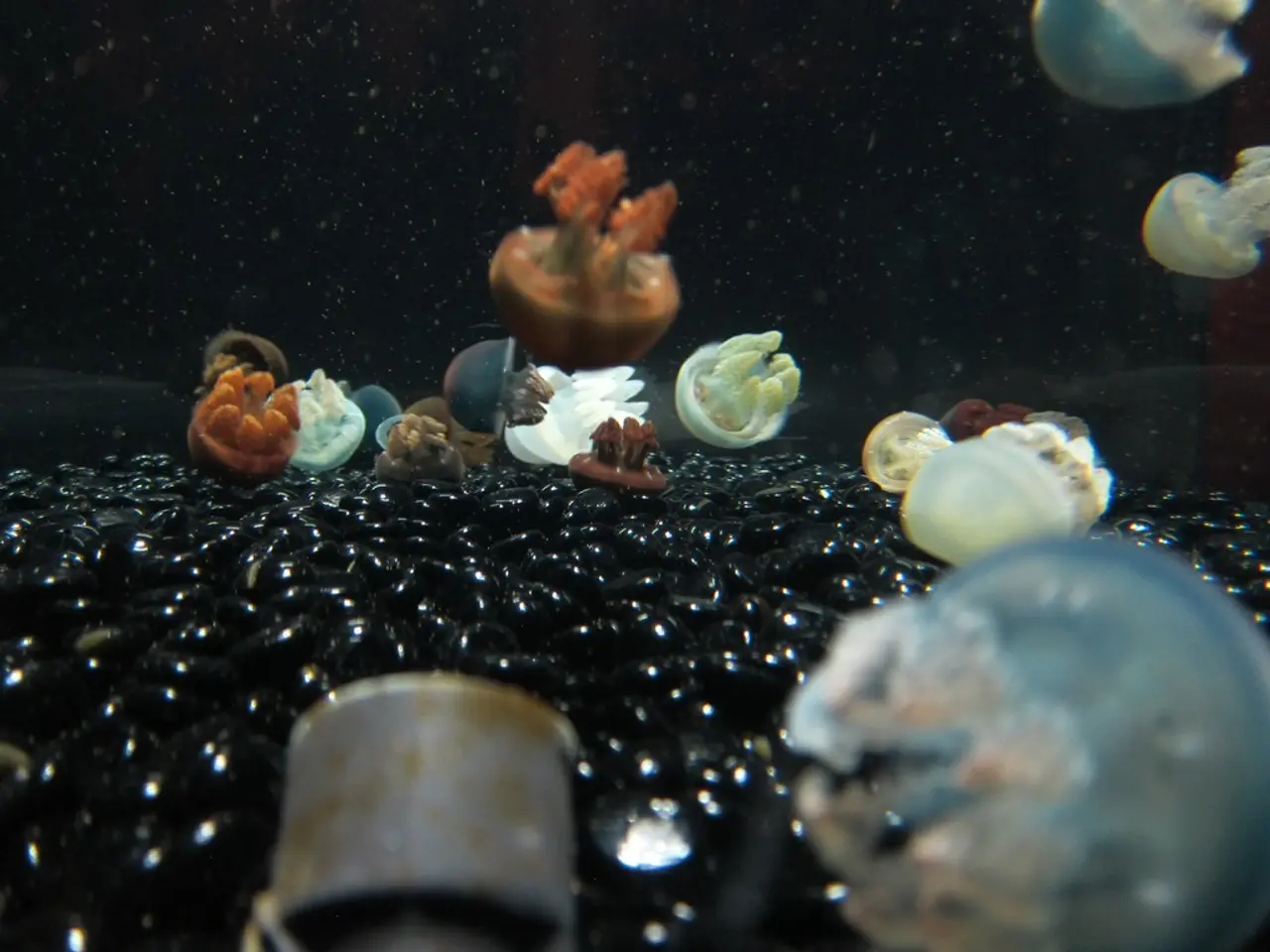Florida Witnesses Fifth Death from Flesh-Consuming Bacteria: Crucial Information Explained
In recent months, Florida and Gulf Coast states have witnessed an increase in Vibrio vulnificus infections, a potentially deadly bacterium that thrives in warm, brackish seawaters. This trend has been linked to climate factors, such as rising sea temperatures, which can elevate Vibrio vulnificus levels and increase infection risks[1].
Causes and Symptoms
Exposure to warm coastal waters, contact with contaminated saltwater or brackish water, and consumption of raw or undercooked seafood, particularly raw shellfish like oysters, can lead to Vibrio vulnificus infections[1][2][3]. Symptoms can vary depending on the mode of infection. Ingestion may cause watery diarrhea, abdominal cramps, nausea, vomiting, fever, and chills, while skin exposure can result in redness, pain, swelling, warmth, and oozing fluid at the site, which can rapidly spread and become life-threatening[2][3].
Prevention and Treatment
To prevent infections, it's advisable to avoid exposure to brackish or saltwater if you have cuts, wounds, or compromised skin. If contact is unavoidable, cover wounds with waterproof bandages. Wash wounds thoroughly with soap and water after exposure to seawater or raw seafood[3]. Vulnerable groups, such as those with liver disease, cancer, diabetes, weakened immune systems, or recent stomach surgery, should exercise caution with raw or undercooked seafood[2][3].
Early diagnosis, aggressive antibiotic therapy, and surgical intervention are critical for successful treatment outcomes[1][5]. Intensive care may be required for sepsis or multi-organ failure, with amputation considered if necrosis worsens[1].
Impact and Precautions
This year, 16 cases of Vibrio vulnificus have been reported in Florida, resulting in five fatalities[6]. The Louisiana Department of Health has reported 17 cases among Louisiana residents, with four resulting in death[7]. Vulnerable populations with underlying health issues are at highest risk of severe disease and should take extra precautions in activities involving coastal waters and seafood consumption[1][3].
The Florida Department of Health advises immunocompromised individuals to wear protective footwear to avoid injuries from rocks and shells on the beach[8]. Health officials urge individuals who develop symptoms after exposure to seek medical attention immediately[9].
This increase in infections likely reflects environmental factors alongside greater awareness and reporting. The man who died from a Vibrio vulnificus infection was vacationing with his family on St. George Island, off Florida's Panhandle, when he contracted the bacteria through a cut on his leg[10]. A death in July in Florida was caused by an infection from eating raw oysters[11].
Last year, Florida saw a surge of Vibrio vulnificus infections, with 82 cases and 19 deaths reported by the state's Department of Health, largely due to the impacts of Hurricane Helene[12]. The statement from the Florida Department of Health noted that the current case count is much higher than in recent years[13].
References: [1] CBS News (2021). Florida sees surge in Vibrio vulnificus infections, causing 5 deaths. [online] Available at: https://www.cbsnews.com/news/florida-sees-surge-in-vibrio-vulnificus-infections-causing-5-deaths/
[2] Centers for Disease Control and Prevention (CDC) (2021). Vibrio vulnificus. [online] Available at: https://www.cdc.gov/vibrio/vulnificus/index.html
[3] Florida Department of Health (2021). Vibrio vulnificus. [online] Available at: https://www.floridahealth.gov/diseases-and-conditions/vibrio-vulnificus/index.html
[4] Mayo Clinic (2021). Vibrio vulnificus infection. [online] Available at: https://www.mayoclinic.org/diseases-conditions/vibrio-vulnificus-infection/symptoms-causes/syc-20371052
[5] National Institutes of Health (NIH) (2021). Vibrio vulnificus. [online] Available at: https://www.ncbi.nlm.nih.gov/books/NBK532953/
[6] Florida Department of Health (2021). Vibrio vulnificus: Cases and deaths by year. [online] Available at: https://data.florida.gov/Health-and-Human-Services/Vibrio-vulnificus-Cases-and-Deaths-by-Year/xk6d-993c
[7] Louisiana Department of Health (2021). Vibrio vulnificus. [online] Available at: https://ldh.la.gov/index.cfm/page/1985
[8] Florida Department of Health (2021). Vibrio vulnificus: Prevention. [online] Available at: https://www.floridahealth.gov/diseases-and-conditions/vibrio-vulnificus/prevention.html
[9] Florida Department of Health (2021). Vibrio vulnificus: Symptoms and treatment. [online] Available at: https://www.floridahealth.gov/diseases-and-conditions/vibrio-vulnificus/symptoms-and-treatment.html
[10] CBS News (2021). Florida sees surge in Vibrio vulnificus infections, causing 5 deaths. [online] Available at: https://www.cbsnews.com/news/florida-sees-surge-in-vibrio-vulnificus-infections-causing-5-deaths/
[11] Florida Department of Health (2021). Vibrio vulnificus: Cases and deaths by year. [online] Available at: https://data.florida.gov/Health-and-Human-Services/Vibrio-vulnificus-Cases-and-Deaths-by-Year/xk6d-993c
[12] Florida Department of Health (2021). Vibrio vulnificus: Cases and deaths by year. [online] Available at: https://data.florida.gov/Health-and-Human-Services/Vibrio-vulnificus-Cases-and-Deaths-by-Year/xk6d-993c
[13] Florida Department of Health (2021). Vibrio vulnificus: Cases and deaths by year. [online] Available at: https://data.florida.gov/Health-and-Human-Services/Vibrio-vulnificus-Cases-and-Deaths-by-Year/xk6d-993c
- The rise in Vibrio vulnificus cases is not only causing concern among health officials, but also in news media, with numerous articles and reports emphasizing the severity of this disease.
- Health and wellness blogs have been highlighting the importance of being aware of this potentially life-threatening bacterium, providing tips on how to stay safe while enjoying coastal activities.
- In the realm of environmental science, researchers are examining the impact of climate change on Vibrio vulnificus levels, as the rising sea temperatures contribute to its proliferation.
- Meanwhile, educational institutions are incorporating discussions on Vibrio vulnificus into their curriculum, as part of a broader focus on medical-conditions that can arise from interactions with the environment.
- Skin-care specialists are emphasizing the need for precautions while spending time near saltwater, stressing the importance of protecting cuts and wounds to reduce the risk of infection.
- Nutritionists, too, are advising people to be cautious when consuming raw seafood, especially during trips to coastal regions.
- Neurological disorders can impact a person's immunity, making them more susceptible to Vibrio vulnificus infections, hence the need for individuals grappling with such conditions to take extra care.
- The increase in Vibrio vulnificus cases has prompted discussions about the significance of submission of proper reports and data to help monitor the situation and implement precautions effectively.
- The Florida Department of Health has been emphasizing the importance of fitness and exercise as a means of strengthening the immune system and increasing overall resistance to diseases, including Vibrio vulnificus.
- Mental-health advocates are recognizing the role of stress in compromising a person's immune system, thereby making them more vulnerable to infections like Vibrio vulnificus, and offering advice on coping mechanisms to help reduce stress levels.
- Crime-and-justice reporting has made mention of the connection between Vibrio vulnificus and illegal activities like casino-and-gambling or the sale of contaminated seafood, raising concerns about food safety and public health.
- Golfers and other sports enthusiasts are being advised to be cautious when playing near coastal areas due to the risk of Vibrio vulnificus exposure, with officials urging them to wash their hands and avoid consuming raw seafood.
- Baseball and hockey teams that train in areas prone to Vibrio vulnificus outbreaks are ensuring their players are well-educated on the risks and precautions, with health assessments and vaccinations being regular parts of the team routine.
- Environmental-science students are studying the impact of Vibrio vulnificus on local ecosystems, as the proliferation of the bacterium can alter the balance of marine life and indirectly affect other creatures.
- The increase in Vibrio vulnificus cases has prompted continuous weather updates as part of public health alerts, enabling people to make informed decisions about their coastal activities, and helping potentially affected individuals seek medical assistance in a timely manner.
- The tennis world is not immune to the influence of climate change and its impact on Vibrio vulnificus, with players rehearsing precautions and monitoring weather reports before scheduled matches in affected regions.




